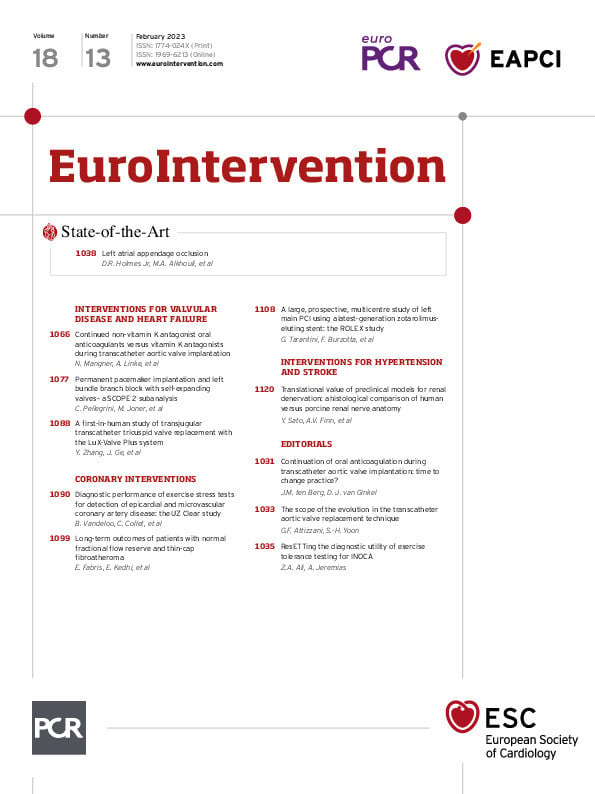Improved transcatheter heart valve (THV) iterations, accumulated evidence and increased operator experience have led to a dramatic decrease in adverse outcomes post-transcatheter aortic valve replacement (TAVR). Nevertheless, the development of new conduction disturbances (i.e., left bundle branch block [LBBB]) and the need for permanent pacemaker implantation (PPI) remain a concern. It is important to remember that progressively younger patients are being treated with TAVR, and thus, the long-term impact of LBBB and PPI post-TAVR should be considered for this population.
In this issue of EuroIntervention, in the present substudy of the SCOPE II trial which randomised patients to undergo TAVR with either the Evolut R (Medtronic) or the ACURATE neo (Boston Scientific) valve, Pellegrini et al evaluated the predictors and clinical impact of LBBB and PPI on an as-treated population, which showed significantly higher PPI rates at 30 days with the Evolut R compared to the ACURATE neo (21.0% vs 12.3%; p=0.004)1. These rates, however, particularly for the Evolut R valve, are substantially higher compared with recent data from the Society for Thoracic Surgeons (STS)/American College of Cardiology (ACC) Transcatheter Valve Therapy (TVT) Registry (8.8% in 2021 second quarter) which encompasses the progressive utilisation of the cusp-overlap technique, associated with increased operator awareness of the importance of THV implantation depth (Harvey J. Decreasing Permanent Pacemaker Implantation Rates in the STS/ACC TVT Registry with a Supra-annular Self-expanding Transcatheter Heart Valve. TVT 2022, Chicago, IL, USA). Indeed, we recently demonstrated significantly higher PPI rates when Evolut valves were implanted at 3 mm or deeper2. It would have been interesting, therefore, to have had access to THV implantation depth data in the current study, as it is a modifiable variable and may have impacted the reported outcomes.
The adoption of a refined THV implantation strategy, namely the cusp-overlap technique, resulted in reduced PPI rates to 9.2% for Evolut valves in the Optimize PRO Study (Grubb KJ. Impact of a standardized TAVI technique and care pathway in the Optimize PRO study. EuroPCR 2022, Paris, France). This technique elongates the left ventricular outflow tract, thus enabling a more precise assessment of THV implantation depth3. Another important aspect for PPI reduction during TAVR with Evolut is consistency on the implantation technique, for example, starting from a higher position and constant pacing, which minimises valve movement and potentially deleterious interactions between the THV and the conduction system. Indeed, we recently demonstrated in more than 1,000 patients treated with Evolut that a consistent technique while aiming for a “shallower” implantation significantly reduced PPI rates (i.e., 5.7% at discharge and 7.0% at 30 days)2. It is unclear in the present study whether there was guidance on an “optimal implantation” technique or how often the cusp-overlap strategy was utilised. Nonetheless, the numerically higher rates of PPI with both the Evolut and ACURATE THV compared to recently published data could potentially have been reduced with consistent, more contemporary, implantation techniques. The ongoing randomised DOUBLE-CHOICE trial will certainly shed additional light on this issue (ClinicalTrials.gov: NCT05036018).
The reasons for conflicting data regarding the clinical impact of PPI are multifactorial: sample sizes, insufficient follow-up durations, patient risk profiles, as well as pacemaker dependency. We reported that patients with >40% right ventricular (RV) pacing, as compared to those with <40% RV pacing, had a higher rate of heart failure hospitalisation (hazard ratio: 5.0, 95% confidence interval: 1.23-20.27; p=0.007) and a trend for higher mortality (hazard ratio: 2.78, 95% confidence interval: 0.86-9.00; p=0.06)4.
The current study also demonstrated higher rates of new LBBB at 30 days after Evolut implantation, compared to ACURATE neo (13.4% vs 5.5%; p=0.007) implantation, which has previously been correlated with an increased risk of all-cause mortality or heart failure hospitalisation at 1 year45. A recent multicentre study also demonstrated the adverse impact of new LBBB after TAVR, particularly among patients with lower ejection fractions6. We recently showed that 8.0% of patients who developed new LBBB immediately post-TAVR required PPI at discharge. Among them, patients who had a shallow THV implantation had lower rates of PPI compared to those who had a deeper THV implantation (2.4% vs 15.9%; p<0.001)2.
The authors and investigators of the SCOPE II trial are to be commended for their dedicated work and contribution to the field. Given the expanding TAVR indications for younger and lower surgical risk populations, our practice should be tailored to individual patients. In general, a shallower THV implantation will decrease the risk of new conduction disturbances and need for PPI, whereas it may hinder future coronary access and redo TAVR. Importantly, not only patient longevity and risk profiles but also anatomic factors (heights of coronary arteries, width of sinus of Valsalva, size of aortic annulus) should be considered when choosing a THV, while balancing the risk of PPI and the feasibility of future interventions in this setting.
Conflict of interest statement
G.F. Attizzani is a consultant, serves as a proctor and is on the advisory board of Medtronic. He is also a consultant for Abbott Vascular. S-H. Yoon has no conflicts of interest to declare.

